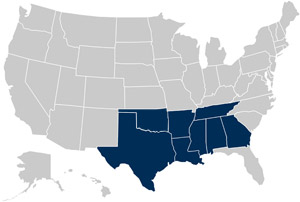What Should Truckers Do in Bad Weather?
Bad weather means thinking about commercial truck safety on the road. Government agencies and insurers provide suggestions and rules for protecting oneself in severe weather conditions. However, in this article, we will explain how you can protect yourself in various severe weather conditions.
Hurricanes
Hurricane season is from June to November, with the worst storms in August and September. On average, there are 12 – 17 named storms each year, with 5 – 9 of those becoming hurricanes. In an average year, 1 – 4 of those will be major hurricanes of 3, 4, or 5.
Being prepared with severe weather safety precautions before the storms hit is crucial. Stay off the roads whenever a hurricane is on the forecast. If you anticipate getting stuck on the road, here’s how you can prepare.
- Conduct a pre-trip safety inspection to make sure everything on the truck is in good working order
- Make sure you have a full tank of gas
- Pay attention to the projected path of the storm
- Be patient and flexible when changing your route
- Look out for downed power lines and busted gas mains
- Slow down and drive cautiously
If you can, take shelter out of the wind and away from rising water during the worst of the weather. Some hurricanes move quickly through an area, and a few moments off the road can help ensure your safety.
Extreme Heat
Extreme heat one of the deadliest weather-related health outcomes in the U.S. An estimated 1,300 people die each year because of extreme heat. The number could be even higher, and experts project it to rise as temperatures increase globally.
Being prepared means taking a few precautions before you hit the road.
- Ensure that cooling systems in your rig are in good working order
- Check and fill all of your truck’s fluids (and keep extra fluids onboard)
- Keep yourself hydrated
- When you can, drive in the early morning and late at night when it’s cooler
- Wear protective coverings (sunglasses, hat, etc.) when working in the heat
- Take frequent breaks to cool off
It’s important to make sure your tires are also properly inflated. Extreme heat increases the temperature of the road and can lead to blowouts.
Tornadoes
Until recently, about one in three tornadoes occurred in an area known as Tornado Alley, which has historically been spanned northern Texas northward through Oklahoma, Kansas, Missouri and parts of Louisiana, Iowa, Nebraska and eastern Colorado. In recent years, hotspots for tornado outbreaks have increasingly moved eastward.
If you are a truck driver or a fleet manager across either stretch of land – the historic or the new Tornado Alley – make sure you are adequately insured. When a tornado touches down, the best bet is to drive the other way. Getting away from a twister can keep you safe and may save your life.
If you can’t, look at these severe weather safety tips to prepare for the inevitable.
- Keep an eye out for warning signs: hail; loud, rumbling sounds; dark or greenish skies; swirling debris or clouds
- If you can’t avoid the tornado, pull over and protect yourself
- Stay in the truck and get low in the cab
- Keep your truck away from structures that might collapse under heavy winds
- If you are out of your truck and in a stable structure, stay where you are until the tornado passes
The best way to stay safe is to avoid tornadoes in the first place. Keep your radio on and listen for the emergency broadcast system. Tornado watch indicates the possibility of tornadoes, warning indicates the sighting of one, seek shelter immediately.
Flooding
In an average year, more than 100 people will die in a flood. In fact, heat is the only weather-related hazard that causes more deaths than flooding. Why? Because many people don’t take the threat of flooding seriously.
This is an even bigger issue for truck drivers, as nearly half of all flood-related fatalities are vehicle-related. Heavy, flooding rain also comes with poor visibility. Slow down to increase your braking distance and decrease the chances of hydroplaning.
There is really only one way to deal with flooding: do not drive through standing water that you cannot see the bottom of. Many innocent-looking pools of standing water are filled with swirling debris and are deeper than you think. Water can rip bridges off their pilings, and it can send even a fully loaded tractor-trailer downstream. When in doubt, follow this safety precaution: “Don’t drown; turn around.”
Even after storms have passed, stay alert. Flash floods can occur up to 12 hours after the skies have cleared. Pay attention to your route and be prepared to make changes to it.
Ice and Snow
You may not associate ice and snow with the South, but freezing weather conditions happen in Southern states more often than you might think. The polar jet stream presses down from the north and meets damp air from the Gulf of Mexico. This collision can cause brief but potent bursts of frozen precipitation that you need to be ready for. Parts of Tennessee can get up to a foot of snow, and the mountains of Georgia frequently see icing in the winter.
OSHA Guidelines for Winter Weather
OSHA stresses the need for safety when commercial drivers drive in winter. Winter road conditions can be dangerous, especially in snowy and icy areas. To mitigate these risks, OSHA advises several key strategies, grouped under the three P’s of Safe Winter Driving:

Prepare
OSHA recommends vehicle maintenance. This includes checking the battery, tires, and wipers. It also involves keeping windows clean and using no-freeze fluid in the washer. You should also carry essential items like. It’s also advised to carry essential items like:
- Flashlights
- Jumper cables
- Abrasive materials (such as sand or kitty litter)
- A shovel
- Snow brush
- Ice scraper
- Warning devices (like flares)
- Blankets
- Food, water, and medication
In case you’re stopped or stalled, stay in the truck, avoid overexertion, use bright markers to signal for help, and run the car just enough to stay warm while ensuring the exhaust pipe is clear.
Plan your route carefully, allowing extra time for travel, familiarizing yourself with the directions, and informing others of your route and expected arrival time. OSHA also advises practicing cold weather driving techniques in safe, open areas to prepare for ice and snow conditions.
Protect Yourself
Always buckle up.
Prevent Crashes
OSHA recommends several safety measures for driving. These include driving at a slower speed and maintaining a greater distance between cars.
Being vigilant of pedestrians is also important. To avoid driver fatigue, it is crucial to get enough rest before driving. Additionally, taking breaks every three hours and considering switching drivers, if possible, are effective strategies.
OSHA rules keep drivers safe in winter by preventing accidents and ensuring safer travel on snowy and icy roads.








